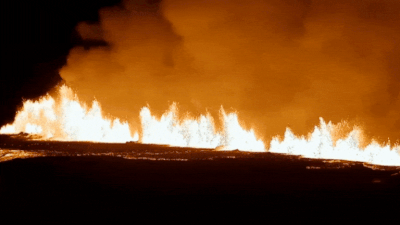A fishing village in southwest Iceland was evacuated late on Wednesday night (local time) following the eruption of the Sundhnukagigar volcanic fissure near Grindavik town, the Icelandic Meteorological Office (IMO) reported.
According to the IMO, the Sundhnukagigar volcanic fissure began erupting at 2314 GMT near Grindavik on the Reykjanes Peninsula.
The volcano, near Iceland’s capital, erupted for the tenth time in three years, spewing fountains of red lava and smoke.
IMO expert Benedikt Ofeigsson informed public radio RAS2 that whilst infrastructure remained safe, authorities evacuated Grindavik, a coastal town renowned for the adjacent Blue Lagoon thermal spa, news agency AFP reported.
The region’s volcanoes remained dormant for 800 years until March 2021, when increased seismic activity commenced.
Live footage from broadcasters displayed bright red-orange lava flowing from an extended fissure, surrounded by dense smoke.
The IMO confirmed this eruption’s intensity was less significant compared to the previous occurrence in August.
The majority of Grindavik’s 4,000 inhabitants were relocated approximately one year ago, preceding the initial volcanic activity in the area. Subsequently, residents have departed after selling nearly all properties to government authorities.
A previous eruption in January resulted in the destruction of three village houses by lava.
The region had entered a new phase of volcanic activity. Iceland hosts 33 active volcanic systems, surpassing all other European nations, Volcanology experts were quoted as saying by AFP.
The country’s position on the Mid-Atlantic Ridge, a geological boundary separating the Eurasian and North American tectonic plates, contributes to its frequent earthquakes and volcanic activity.
